I also have a video showing this trebuchet in action and I go over some of the parts: Make a tennis ball trebuchet video
The heavier the counterweight the better your trebuchet will perform but I would say that 20 pounds is about the limit for this design.
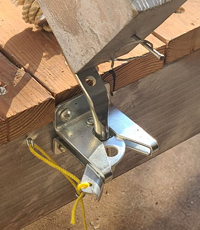
A web visitor (Daniel) has made this trebuchet. And he came up with a clever and inexpensive upgrade to the triggering mechanism. He uses a gate latch that you can buy at any hardware or home improvement store. See how to do this right here. If you are making a trebuchet, or catapult, that is three feet or larger you should check out this improvement.
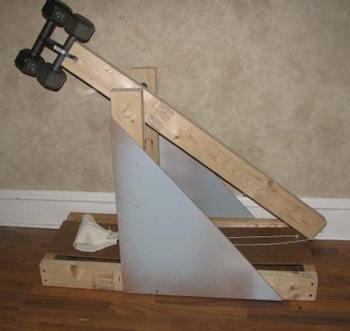
What you need to do this project:
- 2 2x4's that are 36 inches long and 2 2x4's that are 12 inches long (these form the base)
- 2 2x4's that are 23 inches long (the uprights)
- 1 2x4 that is 40 inches long (swing arm)
- 1 piece of 1/4 inch plywood that is approximately 20 inches square. Cut this diagonally to form the two sides. Anywhere from 20-24 inches square is ok.
- 1 piece of flat wood (plywood or something similar) that is 10-12 inches wide and 36 inches long. This is the platform that the string and pouch rest/slide on.
- Approximately 5 feet of string
- A piece of cloth for the pouch that is 10 inches by 6 inches
- 1 dowel or broomstick or pipe that is about 1 inch thick and at least 15 inches long
Tools
- Electric drill
- 1" drill bit
- Hammer
- Saw
- Some nails and screws
Hardware
- Some screws and nails
- 4 eyehooks
- 1 thin and long nail (this is the pouch release nail)
Let's Begin
Layout two of the 2/4's this way
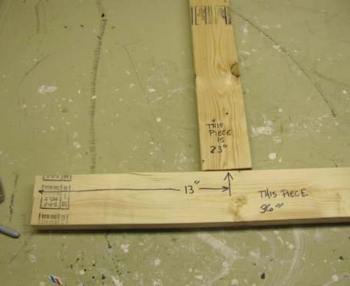
Lay your triangular piece on top of the two by fours as shown and nail it all down securely.
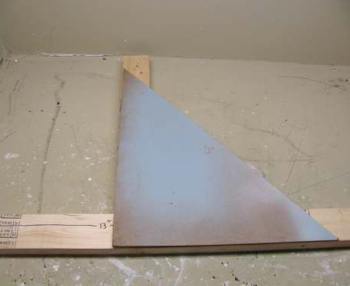
Repeat this procedure again but do a mirror image of this.

Stand these two piece up as shown in the picture below and screw in the two 12 inch pieces as shown. Your trebuchet is half done! I told you this was a fast and easy project!
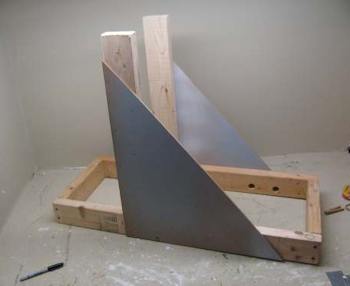
Drill two holes about 2 inches from the top so your bar or dowel fits through them as shown.
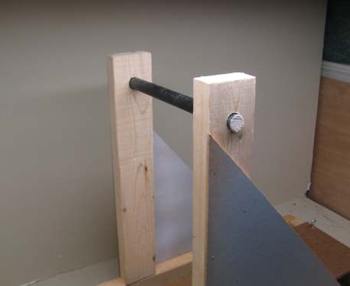
Now screw or nail the baseboard into the trebuchet and screw in two of the eyehooks as shown in the picture below
.
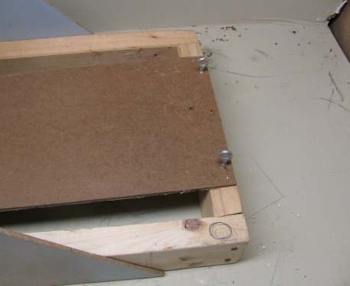
 Let's continue on with the build of this tennis ball trebuchet Let's continue on with the build of this tennis ball trebuchet
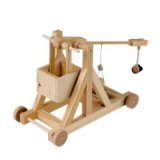 The Miniature Trebuchet by Timberkits The Miniature Trebuchet by Timberkits
The trebuchet was the ultimate artillery weapon of the medieval period and early renaissance. A large and unwieldy weapon, it was typically built on-site during battle, and tuned to lob great weights - such as the carcasses of rotting horses and pots of burning pitch, over the castle walls and onto its inhabitants. Precision carved by computer controlled machinery for guaranteed fit and accurate joinery. The detailed instructions include loads of photos of each step of the construction process, tuning tips and safety notes. Included in the kit are four wooden projectiles, all the necessary components for the sling, trigger, and counterweight bucket as well as all the parts for the kit. The only thing you'll need to supply are 88 pennies for counterweight and a few simple tools - Scissors, a ruler, a utility knife, wood glue and a few rubber bands to hold the pieces together while the glue dries. Manufactured by RLT Industries
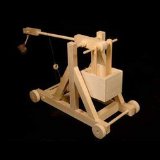 
The Miniature Trebuchet - The trebuchet was the ultimate artillery weapon of the medieval period and early renaissance. A large and unwieldy weapon, it was typically built on-site during battle, and tuned to lob great weights - such as the carcasses of rotting horses and pots of burning pitch, over the castle walls and onto its inhabitants. This is our newest and smallest trebuchet design in a long line of catapult kits. Designed by master trebuchet expert Ron Toms, this machine is ideal for the student on a budget or as a wonderful display piece for any desktop or bookshelf of any history enthusiast. Precision carved by computer controlled machinery for guaranteed fit and accurate joinery. The detailed instructions include loads of photos of each step of the construction process, tuning tips and safety notes. Included in the kit are four wooden projectiles, all the necessary components for the sling, trigger, and counterweight bucket as well as all the parts for the kit. The only thing you'll need to supply are 64 pennies for counterweight and a few simple tools - Scissors, a ruler, a utility knife, wood glue and a few rubber bands to hold the pieces together while the glue dries. Tools required: Scissors, Glue, Ruler, rubber bands and a utility knife. Sandpaper is optional. Additional Counterweight Required: 64 pennies. Range: About 10 feet. - The trebuchet was the ultimate artillery weapon of the medieval period and early renaissance. A large and unwieldy weapon, it was typically built on-site during battle, and tuned to lob great weights - such as the carcasses of rotting horses and pots of burning pitch, over the castle walls and onto its inhabitants. This is our newest and smallest trebuchet design in a long line of catapult kits. Designed by master trebuchet expert Ron Toms, this machine is ideal for the student on a budget or as a wonderful display piece for any desktop or bookshelf of any history enthusiast. Precision carved by computer controlled machinery for guaranteed fit and accurate joinery. The detailed instructions include loads of photos of each step of the construction process, tuning tips and safety notes. Included in the kit are four wooden projectiles, all the necessary components for the sling, trigger, and counterweight bucket as well as all the parts for the kit. The only thing you'll need to supply are 64 pennies for counterweight and a few simple tools - Scissors, a ruler, a utility knife, wood glue and a few rubber bands to hold the pieces together while the glue dries. Tools required: Scissors, Glue, Ruler, rubber bands and a utility knife. Sandpaper is optional. Additional Counterweight Required: 64 pennies. Range: About 10 feet.
|
![]()













